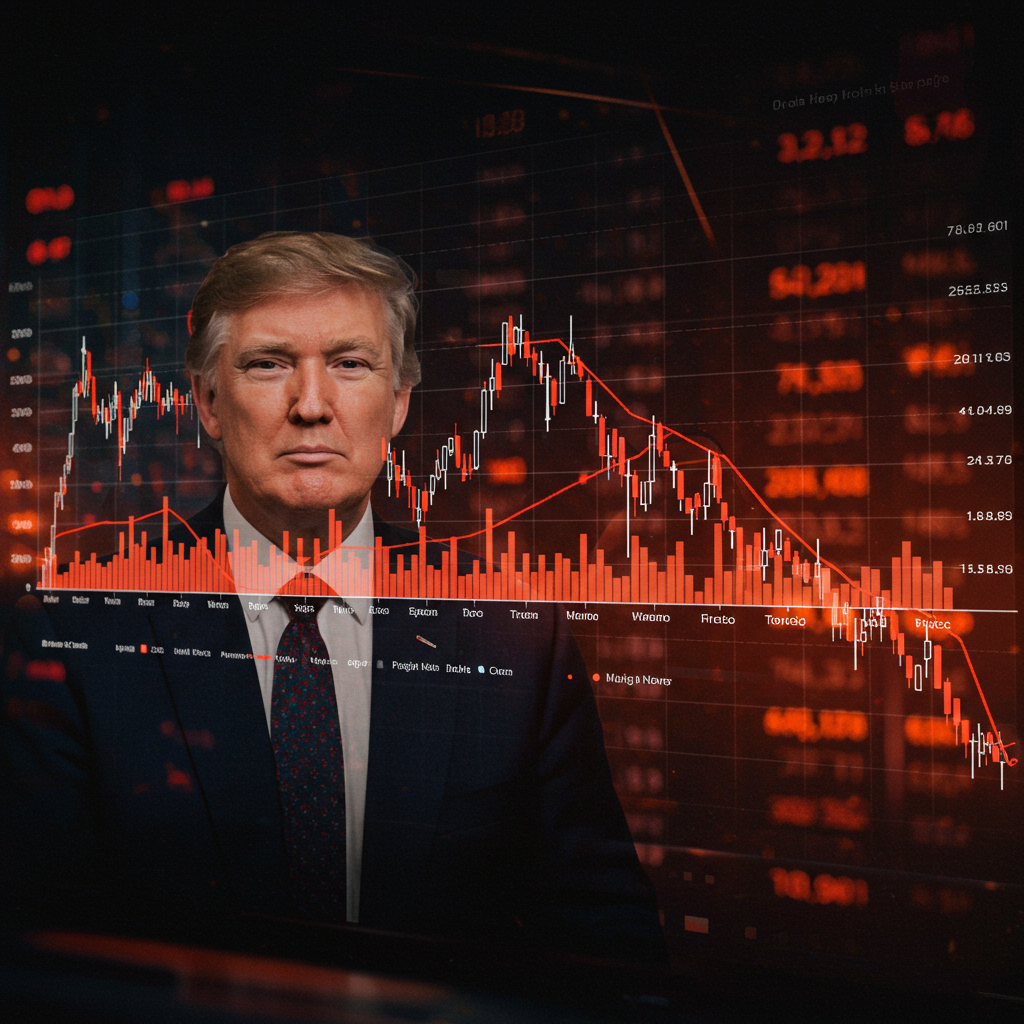Asia-Pacific stock markets displayed a varied performance on Tuesday. Investors carefully weighed impressive recent gains on Wall Street. However, looming uncertainty surrounding U.S. President Donald Trump’s tariff policies created caution. A 90-day reprieve on some tariffs was set to expire soon. This expiration date next week was a key focus for traders globally.
Markets assessed the potential worldwide effects of U.S. trade decisions. U.S. Treasury Secretary Scott Bessent offered insights Monday. He stated that some nations were indeed “negotiating in good faith.” Yet, he added a cautionary note. Tariffs could potentially “spring back” to higher levels. Specifically, he mentioned the rates announced on April 2. This could happen “if we can’t get across the line,” he explained. This would be due to trading partners being “recalcitrant.” His comments underscored the ongoing tension.
Regional Market Snapshot
Market movements across Asia-Pacific varied significantly throughout the day. Mainland China’s CSI 300 index saw a modest gain. It added 0.18% in its final trading hour. The index closed at 3,942.76. This positive movement came alongside encouraging economic data. China’s Caixin/S&P Global manufacturing purchasing manager’s index (PMI) for June registered 50.4. This reading surpassed the 49 forecast by analysts. It indicated expansion in the manufacturing sector.
In contrast, Japan’s benchmark Nikkei 225 fell during the session. It declined 1.24% to 39,986.33. This followed hitting an over 11-month high just the day before. The broader Topix index also decreased. It was down 0.74% in its final hour, settling at 2,832.07. Despite the market dip, recent manufacturing data showed improvement. Japan’s au Jibun Bank flash Manufacturing PMI rose to 50.4 in June. This marked the first expansion reading (above 50) in 13 months. However, underlying demand remained weak. New orders and export sales continued to fall. An economist noted that sustained recovery relies on renewed customer demand. Uncertainty around U.S. tariffs specifically dampened this demand. Separately, the Bank of Japan’s quarterly Tankan survey showed improving sentiment among large manufacturers (+13). Sentiment among large non-manufacturers slightly softened (+34).
South Korea’s markets saw gains. The Kospi index rose 0.58% in its last hour. It reached 3,089.65. The small-cap Kosdaq also advanced. It added 0.28%, ending at 783.67. However, manufacturing activity data presented a mixed picture. South Korea’s S&P Global Manufacturing PMI came in at 48.7 for June. This marked the fifth straight month of contraction (below 50). Although the contraction pace slowed from May (47.7), it reflected ongoing declines. Falls in output, new orders, purchasing activity, and employment contributed to the lower reading. The outlook for coming months appears mixed, according to economists.
Australia’s S&P/ASX 200 index finished the day nearly flat. It closed at 8,451.10. However, specific sectors showed strong performance. Australian gold mining stocks recorded substantial gains. This surge was driven by higher gold prices. Spot gold appreciated 0.77% against the dollar. It traded at $3,328.58. This price rise occurred amid a weaker U.S. dollar and uncertainties. President Trump’s tariff plans added to this market uncertainty.
Elsewhere in the region, India’s benchmark Nifty 50 and BSE Sensex were trading flat. Hong Kong markets were closed for a public holiday.
The Weight of Wall Street and Tariff Uncertainty
Wall Street’s performance significantly influences global markets. U.S. stock futures registered declines in Asian trading hours. This followed a strong session stateside on Monday. Two of the three key U.S. benchmarks hit fresh record highs. The broad-based S&P 500 index gained 0.52%. It closed at 6,204.95. The Nasdaq Composite advanced 0.47%. It also reached a new all-time high of 20,369.73. The Dow Jones Industrial Average climbed 275.50 points. This was a 0.63% rise, settling at 44,094.77.
Monday’s positive close on Wall Street followed news from Canada. Canada rescinded its digital service tax. This move aimed to facilitate ongoing trade negotiations with the U.S. This development came after President Trump’s comment last Friday. He had stated the U.S. was “terminating ALL discussions on Trade with Canada.” The digital tax’s initial payments were due Monday. It would have applied to major tech firms. Companies like Google, Meta, and Amazon would have been impacted.
The backdrop to current market sentiment is President Trump’s active trade policy. Recent weeks have seen rapid developments. This includes proposed tariffs on various imports. Autos, chips, and pharmaceuticals have been mentioned. Previous announcements included tariffs on steel and aluminum. Tariffs on Mexico and Canada were also expected. This frequent policy activity creates volatility. Legal challenges have added another layer of complexity. A court ruling recently deemed some tariffs “unlawful.” However, a federal appeals court temporarily allowed them to stay in effect. This ongoing legal back-and-forth underscores the unpredictable trade landscape.
Experts note the market’s sensitivity to these trade tensions. A previous decision by Trump to delay EU tariffs triggered a significant rally. This highlights how much markets react to perceived de-escalation. Conversely, the potential for new tariffs or the return of previous rates breeds caution. UBS Global Wealth Management suggested that while the U.S. growth gap might narrow, U.S. exceptionalism remains strong. However, they cautioned against a “one-stop allocation” strategy solely focused on the U.S. They projected future U.S. tariff rates. Estimates included 30-40% for China and 10-15% for other countries. An overall U.S. rate of 15% was estimated. The uncertainty over tariff levels and their economic impact continues to be a key factor for global investors.
Currency Dynamics
Asia-Pacific currencies generally strengthened against the U.S. dollar on Tuesday. This appreciation occurred amid uncertainties linked to U.S. policies. President Trump’s spending bill and tariff plans were noted factors. The U.S. dollar index, measuring the greenback against six major currencies, fell 0.13%. It stood at 96.745.
Specific currency movements included the Japanese yen strengthening 0.23%. The yen is often considered a safe-haven asset. It appreciated against the dollar to 143.68. The Indian rupee also gained 0.11%. It moved to 85.59 versus the dollar. China’s offshore yuan marginally strengthened. It was up 0.01% to 7.5175 against the dollar. The Australian dollar appreciated 0.11% to 0.6573. The Taiwanese dollar edged up 0.07% to 29.161.
Not all regional currencies gained. The South Korean won depreciated slightly. It fell 0.03% against the dollar. It traded at 1,352.82. Elsewhere in Southeast Asia, the Singapore dollar remained largely unchanged. It was at 1.2715. The Thai baht weakened by 0.15% to 32.46. The Philippine peso saw a marginal gain of 0.08% to 56.23. The Malaysian ringgit appreciated more significantly, rising 0.48% to 4.19.
Other Key Market and Economic Signals
Beyond the major indices and currencies, specific company news also drew investor attention. Shares of Chiba Kogyo Bank surged sharply. The stock jumped as much as 25.15% Tuesday. This followed a local media report. NHK reported the bank was arranging a “business integration.” This integration would be with fellow Japanese regional lender Chiba Bank. Chiba Bank already holds a significant stake in Chiba Kogyo Bank. It acquired shares in late March. The transaction was worth approximately 23.7 billion yen ($164.99 million).
In the U.S., company earnings and guidance updates have provided insights into the economic climate. While some tech giants like Nvidia have shown resilience despite trade restrictions, others have cited tariff impacts. Best Buy previously cut its full-year guidance due to tariff-related uncertainty. HP Inc. also lowered its forecast, referencing continuing costs from U.S. tariffs on goods from China. The ongoing legal uncertainty and potential for new duties remain significant considerations for companies with international supply chains.
Broader economic data adds context to the market picture. Recent U.S. data showed weekly unemployment aid filings rose more than expected. Continuing claims hit their highest level since late 2021. This suggests it is taking longer for unemployed individuals to find new jobs. This indicates a potential softening in the labor market. An updated reading on first-quarter U.S. GDP showed a slight contraction (0.2% annualized). Durable goods orders also fell in April, largely due to transportation equipment declines, though excluding transportation, orders saw a modest rise. These mixed signals from the U.S. economy contribute to the overall uncertainty factored into global market assessments. Oil prices have also seen movement, with recent retreats occurring amid expectations of OPEC+ potentially increasing production.
Market strategists continue to emphasize the ‘whipsaw’ nature of trade tensions. While robust earnings or easing trade fears can boost sentiment, the underlying policy uncertainty persists. This volatility is expected to continue influencing investor decisions across global markets.
Frequently Asked Questions
What factors caused Asia-Pacific markets to trade mixed on Tuesday?
Asia-Pacific markets showed mixed results primarily due to investors balancing two opposing forces. On one hand, they assessed the positive momentum from record-breaking gains on Wall Street the previous day. On the other hand, they faced significant uncertainty. This uncertainty stemmed from U.S. President Donald Trump’s tariff policies, especially as a 90-day tariff reprieve was set to expire soon. The potential for tariffs to “spring back” to higher levels, as mentioned by the U.S. Treasury Secretary, created caution.
How are US tariff policies currently impacting investor sentiment and regional markets?
U.S. tariff policies are a major source of uncertainty for investors. The impending expiry of a specific tariff reprieve next week raised concerns about potential trade barriers increasing. This uncertainty influences investment decisions by making future trade conditions harder to predict. The potential for tariffs to rise affects companies relying on international supply chains or export markets. This can lead to sector-specific impacts, like driving investors towards assets like gold amid a weaker dollar, as seen with Australian gold mining stocks. Ongoing legal challenges to tariff authority add another layer of complexity.
What key economic data points are investors watching in the Asia-Pacific region?
Investors in the Asia-Pacific region are closely monitoring several key economic indicators. Manufacturing Purchasing Managers’ Indexes (PMI) are crucial, with recent data showing expansion in mainland China’s manufacturing sector but continued contraction (though slower) in South Korea. Japan’s manufacturing PMI showed the first expansion in over a year, but weak demand remains a concern potentially linked to tariff uncertainty. Investors also watch business sentiment surveys like the Bank of Japan’s Tankan, which provides insights into corporate outlooks. Currency movements against the U.S. dollar are also closely tracked as indicators of economic health and sentiment towards U.S. policy uncertainty.
Conclusion
Tuesday’s trading session in Asia-Pacific highlighted a market grappling with competing influences. The optimism flowing from Wall Street’s recent strength provided support for some indices. However, this was tempered by persistent uncertainty regarding U.S. trade policy under President Trump. With a critical tariff deadline approaching and comments from U.S. officials reinforcing the potential for higher duties, investors remained cautious. Regional economic data presented a mixed picture, further contributing to the complex sentiment. The interplay of global strength, regional specifics, and the unpredictable nature of trade policies means that volatility is likely to remain a key feature of Asian markets moving forward. Understanding these dynamics is essential for navigating the current financial landscape.




